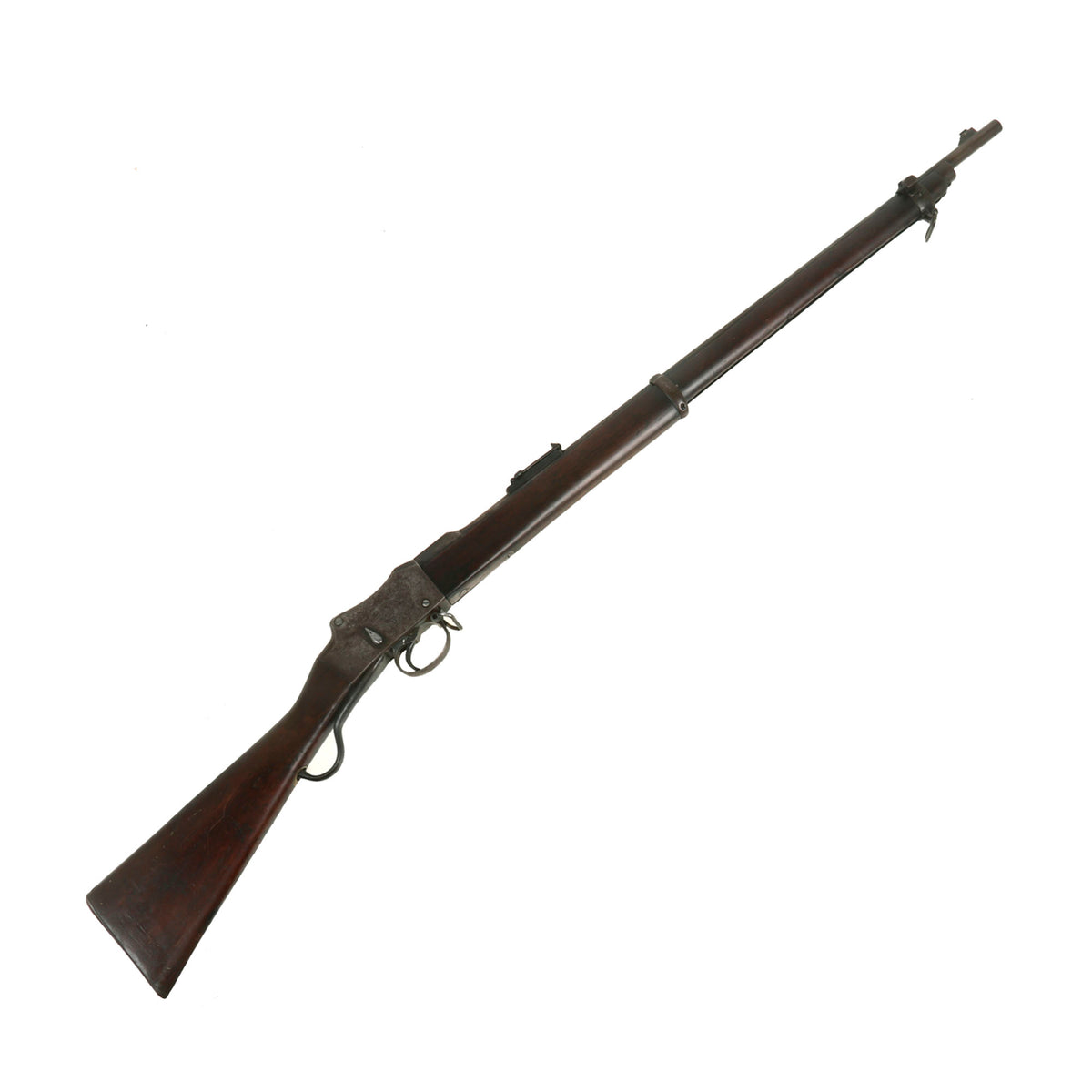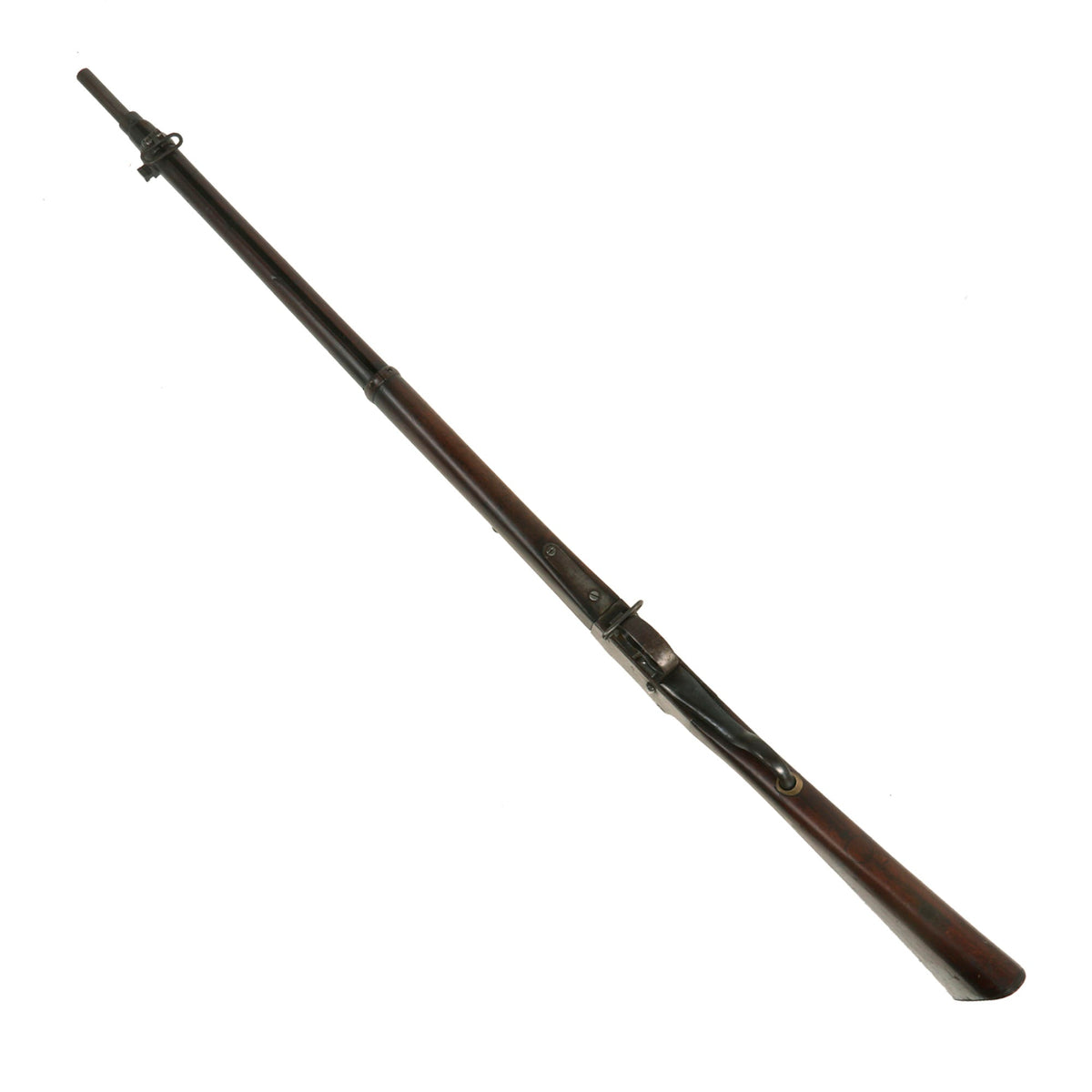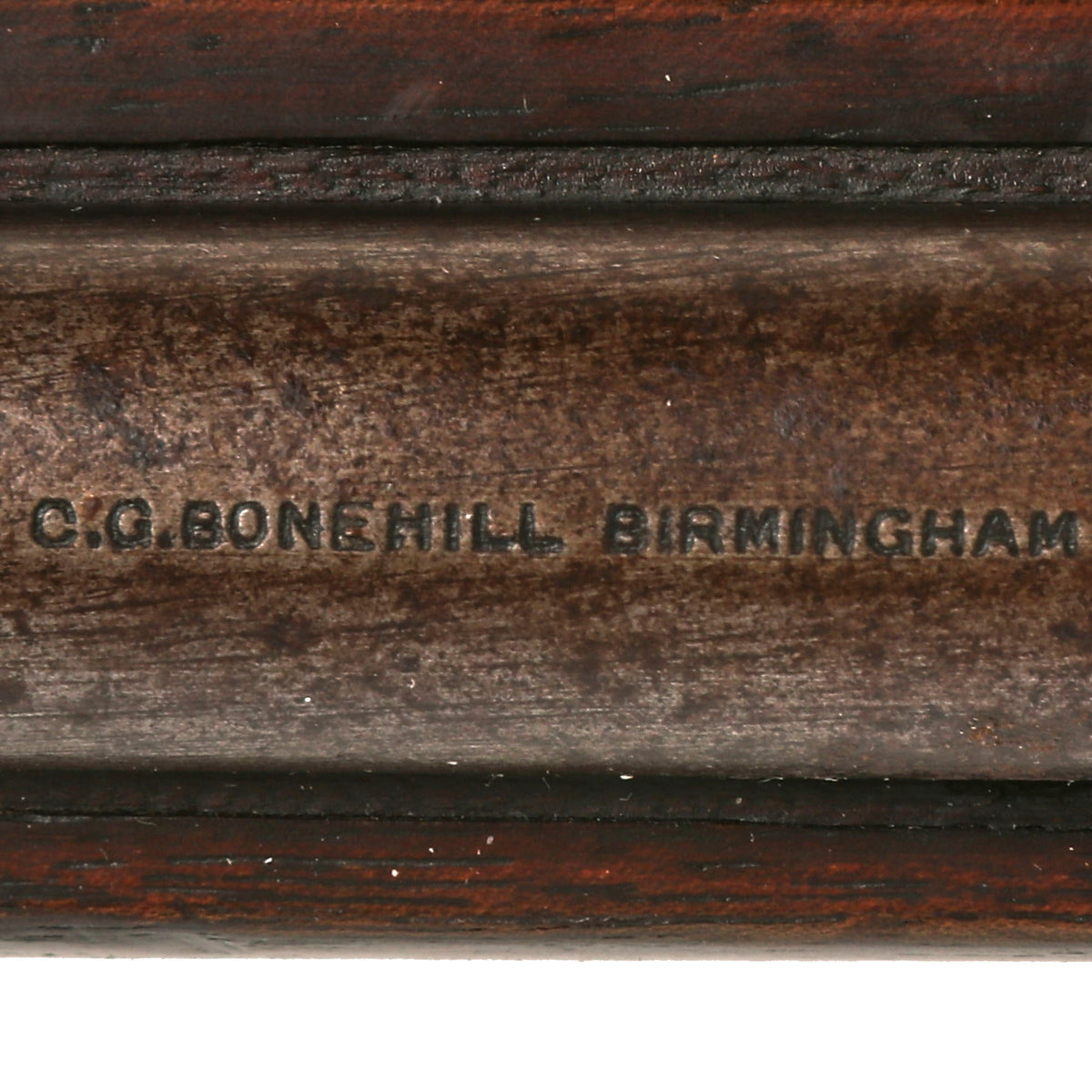Original British P-1885 Martini-Henry MkIV Rifle Converted to .22 Rimfire Trainer by C.G. Bonehill – dated 1886 Original Items
$ 1.895,00 $ 473,75
Original Item: Only One Available. Well this is definitely something we have very seldom seen before: a Martini-Henry long rifle converted to .22 for training use! Usually we see .303 conversions, intended for service, but the platform was also good for converting rifles to use in training. This is one such example, and it was converted in Birmingham England by a well-known maker of the time, though we unfortunately do not know exactly when this conversion took place. Definitely some great research potential here!
Martini-Henry rifles, the original manufacturer information would be stamped onto the right side of the action, while the left side would have information regarding the conversion. This example is marked on the right action with original maker information, which has had the Royal Cypher become somewhat faint, while the rest is still clearly legible:
(Crown)
V.R.
ENFIELD
1886.(Lock Viewer Mark) I.V
1.
The left side is marked with the conversion information for the .22 conversion:
CONVERTED BY C.G. BONEHILL OF BIRMINGHAM
FOR THE SOCIETY OF MINIATURE RIFLE CLUBS
This rifle definitely has led an interesting life, and in fact was converted TWICE! It was originally made as an “Enfield-Martini” by the Royal Small Arms Factory at Enfield Lock. This was designed to use a new .402″ bullet, replacing the earlier .577/.450 Martini-Henry Cartridge. However the introduction of the Lee-Metford in .303 in 1888 instantly obsoleted the Enfield-Martini, so all were converted to become Martini-Henry MkIV “Long Lever” rifles. The “I.V” mark of arm on the receiver is off center, so it was originally just a I., indicating it was converted and not purpose made.
Already obsolete and intended for home use and colonial troops, this rifle was then later converted to .22 Rimfire for use in training, possibly for the military or maybe for cadet use. This was undertaken by Christopher G. Bonehill, an English gunmaker from Birmingham, England who began working in 1872 and continued into the early 20th century. He was quite well regarded, and eventually became a guardian of the Birmingham Proof House. The company installed a completely new barrel, which is also marked by the company, and indicates it is for .22 ammunition, along with British proofs.
Overall the rifle definitely looks like a rifle that saw long service, with the finish faded to a peppery patina on the receiver, and a nice plum patina on much of the barrel. The action cycles correctly with a crisp dry fire, though we have not tested it for any ability to eject cartridges. We checked the bore, and there is rifling present, but it definitely saw much use after being converted to a training rifle. There is wear and some past oxidation and fouling present in the grooves. The stocks are in very good condition, with a lovely color and patina of age. They show a bit of cracking and denting, but nothing major.
A wonderful piece of British and Firearms history! An antique, already over 135 years old and ready to research and display!
The Martini action, adopted by the British in 1871 was one of the strongest ever developed and saw military service in England and the Empire, in one form or another for almost seventy years. The most famous action of course being the defense of Rorke’s Drift in Natal, South Africa in the 1879 Zulu War. They saw extensive use all over the British Empire.
Specifications-
Year of Manufacture: 1886 – later converted to .22lr
Caliber: .22lr
Cartridge Type: CRimfire Cartridge
Overall Length: 30 Inches
Overall Length: 46 1/4 Inches
Action type: Falling-Block
Feed System: Single Shot
Below copy is courtesy of martinihenry-
With the decision to make general issue of the Martini Henry MKII & MkIII to the militia and Volunteers in January 1885 and the impending new .303″ caliber and the suspension and ultimate cancellation of the .402″ bore Enfield Martini in June 1887, it was decided as a short term measure to convert those 65000 .402″ Enfield Martinis already made into a useable .577/450″ arm. The new rifle was to be designated the Martini Henry MkIV at a cost to convert those arms was expected to be 6s 6d per piece.
The success of enhanced extraction of the longer lever of the Enfield-Martini Pattern B rifle was readily adopted for all MkIV patterns, those existing Enfield-Martini A pattern walnut stocks required the brass stock cup re-siting to correspond with the long levers’ tip. The process required a fresh recess hole to be drilled and the cup re-set. A purpose made wooden plug was glued into the hole completing the process. As the stocks were all removed there is no consistency as which stock was fitted to A or B pattern, so they will be found on any pattern. Wherever possible the old components were re-used, and the “E-M” designation originally marked on many of the parts betrays today its original pedigree often scored through thus: E-M. The A pattern trigger assembly, designed to accept the E-M”s safety was reamed to remove the original configuration, whilst Receivers and butt stocks of the old pattern had an extra Roman numeral “V” stamped alongside the original “I”, whilst newly made but un-used components have a distinctive “IV” classification. A new pattern clearing rod, designed to spring into place and to be suitable with use of the new steel jag was installed and the nosecap was redesigned, however it was decided to retain to old pattern Barleycorn on Block foresight on the pattern “A”.
Martini Henry MkIV pattern B & C
The Enfields’ records throw into confusion as to what happened to the 49,902 Pattern B .402″ arms manufactured, these rifles required less conversion, the obvious re-bore to .577/450 calibre, and apart from sighting alteration and re-tooling of the extractor it was a far easier task to convert. These existing Pattern B rifles after barrel conversion to the new .577/450 were designated as the Martini Henry MkIV Pattern “C”, or “conversions”, whilst those rifles made as new pieces, from new components which were rifled to .577/.450″ were known as Martini Henry Pattern “B”,
The author begs to be controversial and also doubts conventional thinking on the issue, In my collection I have a Martini Henry pattern B, with a “B” designation to the serial number, several B markings on the knocks form, and B on the receiver, I have inspected 15 other examples and found the same, all proof marks are single line, not a twin line of proofs clearly, a discrepancy, or maybe proof indeed of the original nomenclature, however to confuse matters, the official List of change No 5603, announcing the issue of the MH MkIV clearly states the knocks form of pattern A & B are 1/8th inch shorter than the pattern C, which ever, the new sealed patterns were offered for adoption and accepted on the same date 15th Sept 1887.
In 1895 BSA & M Co was contracted to refurbish 5000 Martini Henry MkIV, it is to be noted these rifles carry the BSA & M Co logo, however these rifles have Enfield made barrels, and therefore are not BSA original pieces.
Fast Shipping with Professional Packaging
Thanks to our longstanding association with UPS FedEx DHL, and other major international carriers, we are able to provide a range of shipping options. Our warehouse staff is expertly trained and will wrap your products according to our exact and precise specifications. Prior to shipping, your goods will be thoroughly examined and securely secured. We ship to thousands clients each day across multiple countries. This shows how we're dedicated to be the largest retailer on the internet. Warehouses and distribution centres can be located throughout Europe as well as the USA.
Note: Orders with more than one item will be assigned a processing date depending on the item.
Before shipping before shipping, we'll conduct a thorough inspection of the items you have ordered. Today, the majority of orders will be delivered within 48 hours. The delivery time will be between 3-7 days.
Returns
The stock is dynamic and we cannot completely manage it because multiple stakeholders are involved, including our factory and warehouse. So the actual stock may alter at any time. It's possible that you may not receive your order once the order has been made.
Our policy is valid for a period of 30 days. If you don't receive the product within 30 days, we are not able to issue a refund or an exchange.
You can only return an item if it is unused and in the same state as the day you received it. You must have the item in its original packaging.
Related products
Uncategorized
Uncategorized
Uncategorized
Uncategorized
Uncategorized
Uncategorized
Uncategorized
Uncategorized
Uncategorized
Uncategorized
Armoured Fighting Vehicles of the World: AFVs of World War One (Hardcover Book) New Made Items
Uncategorized
Uncategorized
Uncategorized
Uncategorized
Uncategorized
Australian WWII Owen MK1 Machine Carbine SMG Custom Fabricated Replica with Sling Original Items
Uncategorized
Uncategorized












































































